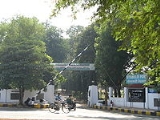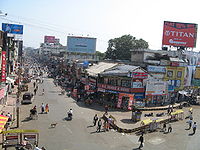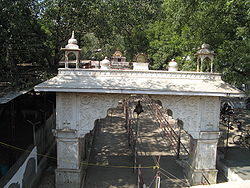
Sitabuldi Fort
Encyclopedia


Nagpur
Nāgpur is a city and winter capital of the state of Maharashtra, the largest city in central India and third largest city in Maharashtra after Mumbai and Pune...
, India, atop a small hillock. The fort was built by Appa Sahib or Mudhoji II Bhonsle
Mudhoji II Bhonsle
Mudhoji II Bhonsle, also known as Appa Sahib, ruled the Kingdom of Nagpur in central India from 1816 to 1818. His reign coincided with the Third Anglo-Maratha War between the Maratha Confederacy and the United Kingdom, which ended with the defeat of the Marathas.On the death of Raghoji II in 1816,...
of the Kingdom of Nagpur
Nagpur kingdom
The Kingdom of Nagpur was a kingdom in east-central India founded by the Gond rulers of Deogarh in the early 18th century. It came under the rule of Marathas of the Bhonsle dynasty in the mid-18th century...
, just before he fought against the British East India Company
East India Company
The East India Company was an early English joint-stock company that was formed initially for pursuing trade with the East Indies, but that ended up trading mainly with the Indian subcontinent and China...
during the Third Anglo-Maratha War
Third Anglo-Maratha War
The Third Anglo-Maratha War was the final and decisive conflict between the British East India Company and the Maratha Empire in India. The war left the Company in control of most of India. It began with an invasion of Maratha territory by 110,400 British East India Company troops, the largest...
. The area surrounding the hillock is now known as Sitabuldi and is an important commercial hub for Nagpur. To the south of the hillock is Nagpur Railway Station
Nagpur Railway Station
Nagpur Railway Station is a railway station in Nagpur, Maharashtra, India.The Nagpur railways constitute a very significant part of the transport and communication system in the city of Nagpur in Maharashtra. Many people from the rest of the country and abroad, visit the city of Nagpur to spend a...
and a temple to Ganesha
Ganesha
Ganesha , also spelled Ganesa or Ganesh, also known as Ganapati , Vinayaka , and Pillaiyar , is one of the deities best-known and most widely worshipped in the Hindu pantheon. His image is found throughout India and Nepal. Hindu sects worship him regardless of affiliations...
(Tekdi Ganapati) is situated at the back of this hillock. The temple was constructed by Bhonsle
Bhonsle
The Bhonsle were a prominent clan within the Maratha clan system who served as rulers of several states in India.The most prominent member of the clan was Shivaji, the founder of the Maratha empire...
kings of Nagpur Kingdom. The fort is now home to the Indian Army
Indian Army
The Indian Army is the land based branch and the largest component of the Indian Armed Forces. With about 1,100,000 soldiers in active service and about 1,150,000 reserve troops, the Indian Army is the world's largest standing volunteer army...
's 118th infantry battalion.
Battle of Sitabuldi
During the Third Anglo-Maratha War, the British had taken control of PunePune
Pune , is the eighth largest metropolis in India, the second largest in the state of Maharashtra after Mumbai, and the largest city in the Western Ghats. Once the centre of power of the Maratha Empire, it is situated 560 metres above sea level on the Deccan plateau at the confluence of the Mula ...
; capital of the Maratha Empire
Maratha Empire
The Maratha Empire or the Maratha Confederacy was an Indian imperial power that existed from 1674 to 1818. At its peak, the empire covered much of South Asia, encompassing a territory of over 2.8 million km²....
. Meanwhile Appa Sahib had taken the throne of Nagpur Kingdom. On getting the news of Peshwa
Peshwa
A Peshwa is the titular equivalent of a modern Prime Minister. Emporer Shivaji created the Peshwa designation in order to more effectively delegate administrative duties during the growth of the Maratha Empire. Prior to 1749, Peshwas held office for 8-9 years and controlled the Maratha army...
's debacle in Pune, Appa Sahib quickly expelled the British emissary. The British embassy was on the other side of Sitabuldi hillock from Nagpur. On 25 November 1817 all communication with the British was severed and Appa Sahib, foreseeing a war, sent his family members and valuables out of the city. The British quickly took over Sitabuldi hill and camped at the fort. The British, led by Captain Fitzgerald, were heavily outnumbered having only 1,400 sepoy
Sepoy
A sepoy was formerly the designation given to an Indian soldier in the service of a European power. In the modern Indian Army, Pakistan Army and Bangladesh Army it remains in use for the rank of private soldier.-Etymology and Historical usage:...
s, 3 troop
Troop
A troop is a military unit, originally a small force of cavalry, subordinate to a squadron and headed by the troop leader. In many armies a troop is the equivalent unit to the infantry section or platoon...
s of Bengal cavalry and four six-pounder guns. Appa Sahib on other hand had 18,000 men, 4000 Arabs and 36 guns.
On 26 December 1817 at 6 pm Appa Sahib's forces attacked the Sitabuldi fort. Initially, the British were heavily outnumbered and completely surrounded. British were heavily resisting a strong attack from Arabs too. Later, Captain Fitzgerald ordered the three Bengal cavalry troops to charge the Arabs. The surprise attack created panic and the Arabs retreated. British sepoys later charged down the hill into the Maratha army to disperse them further, creating confusion and panic. The fiercely fought battle continued till noon on 27 December, and ended with the British achieving victory. Appa Sahib fled after the defeat and the British ambassador established the Appa Sahib's grandson as king while taking control of the kingdom.
After the Battle of Sitabuldi the barracks and other structures were constructed to convert it into a stronger fort.
During British Raj
The graves of British soldiers who died in the battle of Sitabuldi remain in the fort. After the crushing of the 1857 rebellionIndian Rebellion of 1857
The Indian Rebellion of 1857 began as a mutiny of sepoys of the British East India Company's army on 10 May 1857, in the town of Meerut, and soon escalated into other mutinies and civilian rebellions largely in the upper Gangetic plain and central India, with the major hostilities confined to...
, Tipu Sultan
Tipu Sultan
Tipu Sultan , also known as the Tiger of Mysore, was the de facto ruler of the Kingdom of Mysore. He was the son of Hyder Ali, at that time an officer in the Mysorean army, and his second wife, Fatima or Fakhr-un-Nissa...
's grandson Nawab Kadar Ali and his eight associates were hanged on the ramparts of Sitabuldi fort for fighting against the British East India Company. A mosque is maintained in the fort to mark the hangings. The graves along with the mosque are maintained by the Indian Army as a mark of respect for the gallantry of all those who died. A memorial has also been constructed to the soldiers who fell during the colonial period.
Mahatma Gandhi was imprisoned in the fort from 10 April to 15 May 1923. King George V
George V of the United Kingdom
George V was King of the United Kingdom and the British Dominions, and Emperor of India, from 6 May 1910 through the First World War until his death in 1936....
and Queen Mary
Mary of Teck
Mary of Teck was the queen consort of the United Kingdom and the British Dominions, and Empress of India, as the wife of King-Emperor George V....
of the United Kingdom gave audience to the people of Nagpur from the fort during their visit to British India. A pillar to commemorate the event stands in the fort. The royals were greeted by a huge crowd gathered at the area towards the present Nagpur Railway Station.
Current status
The fort is now home to the Indian Army's 118th infantry battalion. The fort was initially open to the public on 2 days a year, but since 19 May 2007 it is now open all year.M.S Naravane reports that when he visited the location of the Battle of Sitabuldi in 1993, he found the graves of British soldiers were kept tidy, clean and immaculate where as the cell where Gandhi was imprisoned was unclean, littered and full of cobwebs.

